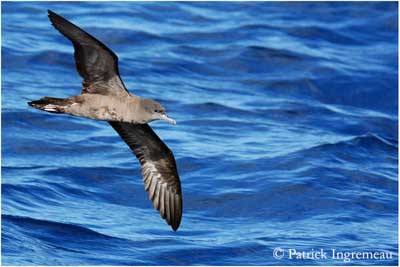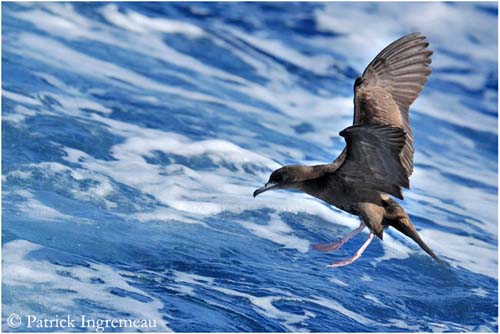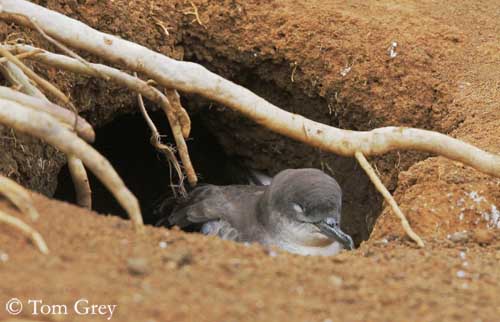
Wedge-tailed Shearwater
Ardenna pacifica
Procellariiforme Order – Procellariidae Family
BIOMETRICS:
Length: 43 à 48 cm
Wingspan: 97 à 104 cm
Weight: 390g
LONGEVITY: Up to 29 years
DESCRIPTION:
Wedge-tailed Shearwater is a pelagic seabird, which is polymorphic with two phases of plumage: light and dark.
Wedge-tailed Shearwater is the largest of tropical shearwaters.

This species is threatened by deterioration of burrows by heavy rains and humans, by ingestion of plastic, load, and others at sea, by pesticides and other toxics present in their eggs, and by oil pollution on sea surface.
The future of Wedge-tailed Shearwaters also depends to maintenance of its food resources at sea.
Fr: Puffin fouquet
All : Keilschwanz-Sturmtaucher
Esp : Pardela del Pacífico
Ital : Berta del Pacifico
Nd : Wigstaartpijlstormvogel
Sd : Kilstjärtslira
Photographs of the flying birds by Patrick Ingremeau
His website:
TAMANDUA
Photograph at burrow’s entrance by Tom Grey
His website : Tom Grey's Bird Pictures
Text by Nicole Bouglouan
Sources:
HANDBOOK OF THE BIRDS OF THE WORLD vol 1 by Josep del Hoyo-Andrew Elliot-Jordi Sargatal - Lynx Edicions - ISBN: 8487334105
All About Birds (Cornell Lab of Ornithology)
New Zealand birds and birding (Narena Olliver)
Wikipedia (Wikipedia, The Free Encyclopedia)
What Bird-The ultimate Bird Guide (Mitchell Waite)
Light morph has greyish-brown upperparts. Underparts are white with dark wing edges. Undertail coverts are dark.
Hooked bill is blackish and we can see tube-like nostrils at upper base of the bill. Eyes are dark brown. Legs and feet are flesh-coloured.
Dark morph is sooty-brown overall.
Both sexes are similar.
Immature resembles adult. It reaches its sexual maturity at 4 years.
Wedge-tailed Shearwater’s name comes from its wedge-shaped tail. It has long, thin wings and hooked bill.

VOICE: SOUNDS BY XENO-CANTO
Wedge-tailed Shearwater utters loud groans, moans and wails. They utter series of short calls during courtship displays. Defence of nest is accompanied by strong calls which continue during combats. Vocalizations occur at night in breeding colonies.
HABITAT:
Wedge-tailed Shearwater is pelagic, living in tropical and subtropical open oceans. Nesting occurs in flat islands or sandy spits with some vegetation or not. Burrows need sandy soils or of volcanic origin.

RANGE:
Wedge-tailed Shearwater ranges across the Tropical Pacific and Indian Oceans. It breeds in islands off Japan, the Islas Revillagigedo in Pacific Ocean, the Hawaiian Islands, the Seychelles and off Western Australia.
BEHAVIOUR:
Wedge-tailed Shearwater cannot stand upright on its legs, because of posterior placement of legs. It is clumsy when moving on the ground. It feeds on water surface, under the surface and in the air. It flies low from water and performs contact-dipping. It snatches prey from water. However, most of them dive for food until 14 metres in depth. It uses wings and feet for propulsion into water.

Wedge-tailed Shearwater returns to breeding colonies at dusk, and leaves it at dawn. It spends most of the day-time at sea.
If a bird enters wrong burrow, it is strongly ousted by violent flapping of wings, accompanied by loud yowls. In fight, birds use only the bill.

In some parts of the range, digging burrows takes part in courtship and pair bond maintenance. Usually, during the day, pair may sit close to the entrance and “coo” continuously while rubbing each other’s head and neck. At night, pair sits on ground, face to face, puffing out their throats and giving prolonged wailing duets, rising and falling in volume.
Copulation is followed by self and mutual preening. Breeding success influences mate fidelity.
Wedge-tailed Shearwaters return to their natal colony to start breeding at about four years of age. They are monogamous, and form long-term pair-bonds for several years.

FLIGHT:
Wedge-tailed Shearwater performs glides on rigidly outstretched wings, alternated with several rapid and stiff wing beats. It usually flies at about 10 metres above water. Tail is pointed in flight.
REPRODUCTION:
Breeding season occurs from February to November, according to the place.
Wedge-tailed Shearwater nests in burrows on the ground, or in natural crevices, or sometimes under cover on ground. They breed in colonies on small islands.
Nest-site is usually at sea level. They also can use deep communal burrows in walls of rain gullies. There are often three tunnels, one on top of the other.

Both adults excavate the burrow with bill and feet. They have long and strong tarsi, well adapted for digging. Nesting chamber may be lined or not. Both sexes collect vegetation in vicinity of burrow, often grass or twigs.
Female lays only one white egg in a nesting chamber situated at the end if the burrow. Incubation begins immediately after laying, and lasts about 48 to 56 days. Both parents incubate the eggs. At hatching, chick is covered with pale or dark grey down, paler on underparts. Bill is light slaty or bluish-grey.
One of both parents remains at nest the first week after hatching. Then, one parent visits each night. Burrow remains clean, birds defecate outside of entrance.
Chick is fed by regurgitation, with bill inserted crosswise into parent’s beak. Feeding takes place every 24 hours.
Young fledge about 100 to 115 days after hatching.
This species produces only one brood per year.

DIET:
Wedge-tailed Shearwater feeds mainly on fish, squid and crustaceans. It feeds during the day, singly or in mixed flocks.
PROTECTION / THREATS / STATUS:
Chicks may wander from burrow, and roll down slope in ground. Then, they die by starvation.
Nestlings can be buried by mud after heavy rains. Destruction of burrows is result of human intrusion or heavy rainfall. Older nestlings leaving colonies prematurely may perish at sea after evacuation by heavy rain.
Predators such as sharks, Barn Owls and dogs, destroy nestlings and adults.
